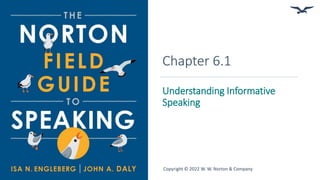
Norton Field Guide for Speaking 6.1
- 1. Chapter 6.1 Understanding Informative Speaking Copyright © 2022 W. W. Norton & Company
- 2. Introduction • Informative speaking is the most common type of presentation • An informative presentation is efficient and effective when it gains and maintains audience attention, is well organized and well rehearsed, uses a variety of supporting material, is delivered expressively and confidently, and encourages audience involvement 2
- 3. What Is an Informative Presentation? • Informative presentations provide new information, explain complex concepts and processes, and/or clarify and correct misunderstood information • It may be difficult to determine the difference between an informative presentation and a persuasive presentation, as most informative presentations contain an element of persuasion • Your purpose clearly divides the line between informative and persuasive presentations 3
- 4. Informative Speaking Guidelines • Gain and maintain audience attention • To build an impressive informative presentation: • Include a value step • Avoid information overload • Employ sensory images 4
- 5. Include a Value Step (1 of 2) • A value step explains why your message should matter to your audience and the benefits it can have: • Social benefits • Communal benefits • Physical benefits • Psychological benefits • Intellectual benefits • Economic benefits • Professional benefits • Begin your search for a value step is through audience analysis 5
- 6. Include a Value Step (2 of 2) Following two examples identify several reasons why audience members may be motivated to listen to and remember what you say about the selected topic area TOPIC: Combating fire ants POSSIBLE VALUE STEPS: Prevents painful, dangerous stings (physical) Preserves gardens (economic) Protects pets and local wildlife (communal) TOPIC: Reading music POSSIBLE VALUE STEPS: Helps you become a better musician or more appreciative audience member (professional and psychological) Helps you understand the complexity of musical compositions (intellectual) Helps you talk about music with other music lovers (social) 6
- 7. Avoid Information Overload (1 of 2) • Information overload describes the stress that occurs when you try to process, understand, and remember everything you hear and see • Narrow the scope of your purpose and topic • Make sure your purpose statement is specific, achievable, and relevant and your key points and supporting material directly support and advance a specific, achievable, and relevant purpose • Remember to “Keep it simple, speaker” and apply the Rule of Three 7
- 8. Avoid Information Overload (2 of 2) LISTENER: I heard your presentation on the new employee evaluation plan. SPEAKER: What do you remember about what I said? LISTENER: Well, you went through the plan page by page, explaining how the new provisions would apply. SPEAKER: What was one of the new provisions? LISTENER: Well ... there was something about new forms to be filed with human resources, I think. I don't know- I'll look it up when I have to use it. • Here, the speaker should make sure that all employees already have a copy of the evaluation plan • The audience could ask questions or look up the information later, if necessary 8
- 9. Employ Sensory Images • Effective speakers make informative presentations more interesting and memorable by using language that evokes a sensory experience • Find ways to apply each of the five senses to your topic: • Sight: A thick brown cookie with visible chips • Sound: A cookie that doesn’t snap when it’s broken • Taste: A sweet cookie dough mixed with strong chocolate • Smell: A cookie with a mouth-watering smell during and after baking • Touch: A soft and chewy cookie 9
- 10. Two Types of Informative Presentations (1 of 3) • Effective informative presentations require a clear purpose, interesting information, and a logical organizational pattern • Informative speaking also requires a sound strategy that matches your informative purpose and content to audience characteristics, interests, attitudes, and needs • Reporting new information creates or increases audience awareness about an object, person, event, or procedure • Explaining complex ideas enhances or deepens audience understanding about a difficult term, a complex phenomenon, or a frequently misunderstood idea or concept 10
- 11. Two Types of Informative Presentations (2 of 3) 11
- 12. Two Types of Informative Presentations (3 of 3) REPORTING NEW INFORMATION AND EXPLAINING COMPLEX IDEAS Goal: To report new information Goal: To explain complex ideas • A recipe for chocolate cake • Directions to the nearest airport • A report about a city council meeting • Baseball trivia • A short biography of Charles Darwin • The principles of baking • The architectural requirements of modern airports • An in-depth analysis of a proposed bill • Detailed analysis of last year's World Series • A description of natural selection 12
- 13. Conclusion • You’ll make informative presentations more often than any other • To improve the quality of your informative presentation and merit a positive response from your audience: • Put a value step near the beginning of your presentation • Minimize information overload • Use sensory images • Determine whether you will be reporting new information or explaining a complex idea 13
- 14. Credits This concludes the Lecture PowerPoint presentation for Chapter 6.1. For more resources, please visit The Norton Field Guide to Speaking: http://digital.wwnorton.com/nfgspeaking. Copyright © 2022 W. W. Norton & Company
